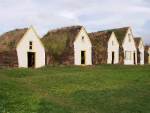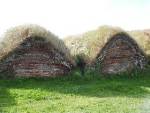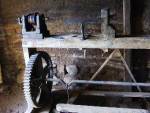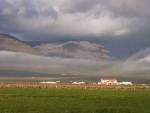A good night's sleep
during which the heat from the radiators completely dried all our clothing
and the wet tent as well. Breakfast with our Belgian friends then a check
on the weather forecast at the tourist bureau: wind 8 to 13 meters per second
(measured NW up to 39 km/h, exactly in the direction that we must head) gradually
weakening. We thus decided to await this famous weakening before getting under
way. And again, the luxury of travelling in the camping car to visit a very
old farm called Glaumbaer dating back to the end 19th century with peat walls
and roof covered with grass and dandelions. What I found most interesting
was the description of the way of life in these small and very crowded houses.
"The living room where the farmer, his family and the servants took their
meals, worked and slept, included 11 beds (as 2 people often shared the same
bed, this room could shelter a score of people). In premises with so little
space, friction between people could only be avoided by general self control
and mutual respect and tact, and this room like any environment, created its
own code of conduct: a convention respecting each individual's private life:
what one kept under one's pillow was as safe from any ferreting as if it had
been in a strong safe." (Extracts of the museum brochure.) It is perhaps
a far-fetched interpretation, but I have the impression that this old way
of life could explain the respectful but nonetheless cordial distance of the
inhabitants of this island as well as the very low rate of criminality (lowest
in the world apparently) giving us the feeling that our belongings, even unattended,
were in safety. (We didn't take a bicycle lock with us. Too much extra weight!).
To finish with and
in spite of our endless patience waiting for a lull in wind strength, at 5
PM it was still blowing a gale. We even made a small attempt, putting the
bicycle on the road with the intention of making a few km of headway towards
Reykjavik but the wind was so violent that we did not dare to even try pedalling.
Our anemometer showed 39 km/h but considering the noise made by the propeller
because of a faulty bearing and the definate impression the storm was stronger
than the one we had experienced before arriving at Myvatn, we estimated that
it was blowing a good force 6, that is well beyond 45 km/h. We were condemned
to remain here a little longer. Anne took advantage of this turn of events
to dye her hair. Although I did not see the urgency of this lengthy procedure
from an aesthetic view point, I was all for it on the basis that we would
no longer have to tow several small bottles of chemicals for another several
hundred km! Anne was delighted in feeling beautiful again (for me she was
before but gradually, she was having more and more difficulty sharing my opinion)
and releived in having succeeded in rinsing her hair and getting dressed just
before the arrival of two cyclists since just 5 minutes earlier, she was still
in scanty underwear in this dormitory which we had come to consider as ours.
The cyclists were an Englishman and Jean-Jacques from Paris who had pedalled
together to Akuryeri and whom we had seen in Myvatn a few days ago. The Englishman
had brought with him a recorder (with 6 holes) on which he played beautifully
in the dining room, mainly Irish tunes. Later in the evening we were joined
by a Chilean woman who had married and divorced an Icelander but who still
lived in Reykjavik. She had come here for the annual meeting of an association
of tree planters (at least that's what I understood ). It seemed very weird
to us that a national meeting could be held in a town of only 130 inhabitants!
|
Glaumbaer
farm
|
Peat walls
|
Wood lathe
|
Sunset at
Varmalid
|



